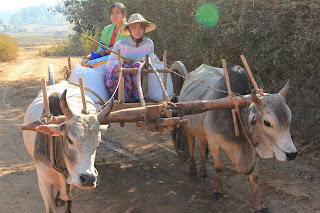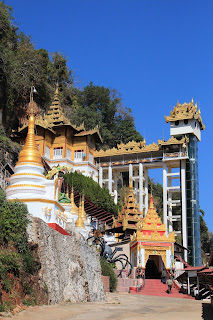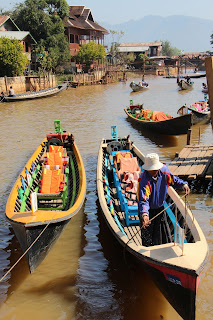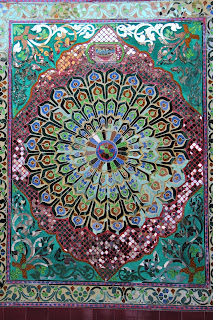See Temples in Myanmar in 2013
Part 2
23 -- Inwa – the monastery
We also had a photo stop at the vast Maha Aungmye Bronza Monastery, built in 1822, and famous for its many forms of Burmese architecture.
24 -- Mt Popa
Mt Popa is an old volcano in central Myanmar, 1518 m above sea level. Nearby is a volcanic plug outcrop called Mt Taung Kalat, (Pedestal Hill) 737 m above sea level. For tourism purpose this Pedestal Hill is sometimes called Mt Popa too. On top of this outcrop is the Popa Taung Kalat Monastery. It is a Buddhist monastery but at the lower terraces of the shrine are housed the famous 37 nats (spirits) in Burmese folklore, which make the place famous. There are 777 steps in covered terrace to reach the top. A few ladies were frightened by the number 777 and chose not to go up. Anyway nothing to shop up there. Smart girls! Shown this Pedestal Hill from a distance, stupas lining the edge of the rock outcrops, and dragons and other decorations.
25 -- Bagan - Land of Thousand Temples
Bagan is an area in the Mandalay region. From the 9th to 13th century, it was the capital city of the Kingdom of Bagan, the first kingdom to unite the regions which later became modern Myanmar. An historic place. Today it is the name of an area about 65 sq km administratively called the "Bagan Archaeological Zone". The main town is Nyaung U.
During its glory days more than 10,000 temples, shrines and monasteries were constructed in the Bagan plains. Today about 2,200 remain. These constitute the main driver of tourism in Bagan and Myanmar. A place really befitting the name of "Land of Thousand Temples". Shown views of the land and the temples taken from the upper terrace of the Shwesandaw Paya. And some typical stupas, of different shapes and designs, mostly masonry.
27 -- Shan State
We are now in Shan State, of the Shan tribe. Shown are rural scenes. A colourful field planted with different crops and a buffalo cart, with lady drivers, and the washing of buffalo carts at a roadside washing bay.
A famous sight visited in the town of Pindaya is the Shwe Oo Min Cave which houses thousands of Buddha images consecrated over centuries. The cave is guarded by a giant spider thought to be the original resident of the cave.
28 -- Lake Inle – floating gardens
Lake Inle is a fresh-water lake in the State of Shan. It is the 2nd largest lake in Myanmar, with a surface area of 116 sq km, about half the size of Kuala Lumpur. The average depth of water is only about 2.1 m in dry season and 3.5 m in wet season. About 70,000 people (called the Intha) live in towns and villages bordering the lake. Many live on simple stilt houses of timber or bamboo. It supports a thriving tourism because of the way of life there. An attraction is the floating garden. Farmers gather lake-bottom weeds to form the floating beds of their gardens topped with soil, and anchored by bamboo poles. These gardens would rise and fall with the water level, so no flooding problem. Vegetables are planted on these islands. Shown the floating garden and typical houses.
29 -- Lake Inle - the fishermen
Another touristic attraction at Lake Inle is the unique way the fishermen paddled their boats. They use a single leg to paddle the blade of the oar in a snake-like motion. And fishing is an important industry. The common fishes are carps. Nevertheless we did enjoy the BBQ tilapia on consecutive nights.
30 -- Lake Inle - what else to see
Of course more things to see, like sea gulls that may "bomb" you with "apa nama tu", or speed boats to splash you if you go too close to them. The other photos show traffic jam of boats in the congested narrow canals.
31 -- Lake Inle - temples
Temples to see, what else? The Shwe Inn Thein Paya near the town of Indein is an old temple complex with more than 1,030 ruined stupas. Very impressive indeed. Many are in the process of being restored by individual donors. Shown some old and some new stupas.
32 -- Lake Inle - more temples
More temples to see, what else? This Phang Daw Oo Paya is famous for its Buddha statues. The temple houses five small gilded images of Buddha, which have been covered in gold leaves to the point that their original forms could not be related. The old photograph hanging on the monastery wall shows the statues in the original pristine form.
33 -- Lake Inle - more more temples
More more temples to see, what else? This one called Shwe Yaunghwe Kyaung is about 200 years old. The main monastery structure is built with teak with unusual oval windows. There are many Buddha images in the adjacent buildings, each in a niche, as well as frames of coloured mosaic tiles telling the life story of Buddha.
34 -- Mandalay – Sutaungpyai Temple
(Note in 2021 – Feel compelled to add this elegant temple which is not covered in the original 2013 email account. So we go back to Mandalay.)
This Sutaungpyai Paya is worthy to be introduced as it was founded sometime in the 1050s and has been patronised over the years by many kings. It is located near the top of the Mandalay Hill. The present structure is unique in that many glazed green ceramic titles were used on the walls. Very elegant.
35 -- the last photos
Showing some well-crafted wooden Burmese souvenirs here.
And a few interesting photos to conclude the story: a field of jars in a village near Bagan, a water-melon seller in a temple in Bagan, and the mobile non-LED "flight information board" at the small Heho Airport at Lake Inle. We took a local flight from Lake Inle back to Yangon.
Tour Promoter - The tour promoter is YonGo Travels (www.yongo.biz). This is in fact their recee trip lead by LM, the boss.
Apology: I might have used inappropriate words to talk about Buddha, or monks or stupas. Just a way to make the story more interesting. Nothing disrespectful. My apologies if anyone feel offended.
Photography: Photos are taken with my basic Canon EOS 600D.
Cezu tin ba deh (thank you) for reading. Nout ma thway mae (see you again)
(First written in March 2013 and circulated in the email format. Lightly revised to this PDF format in March 2021)
































































No comments:
Post a Comment